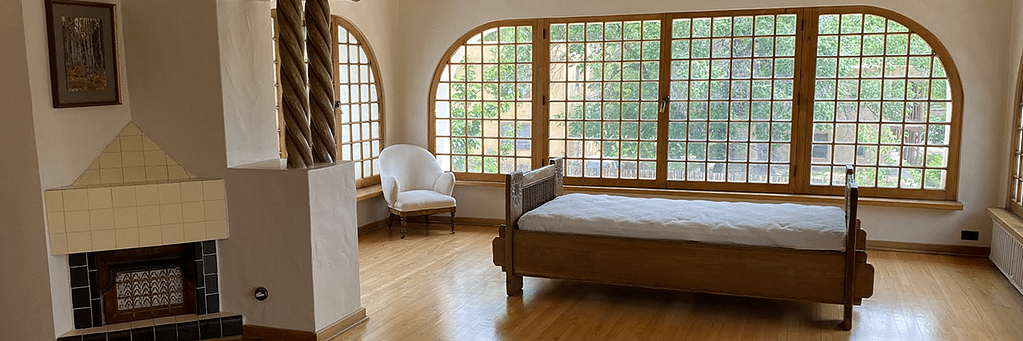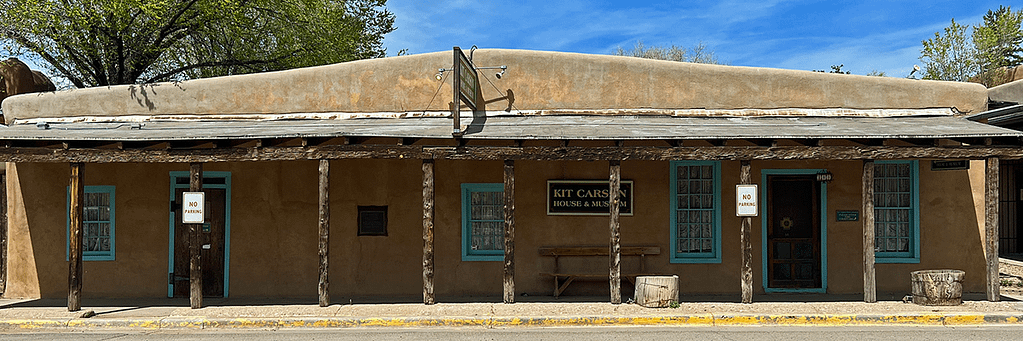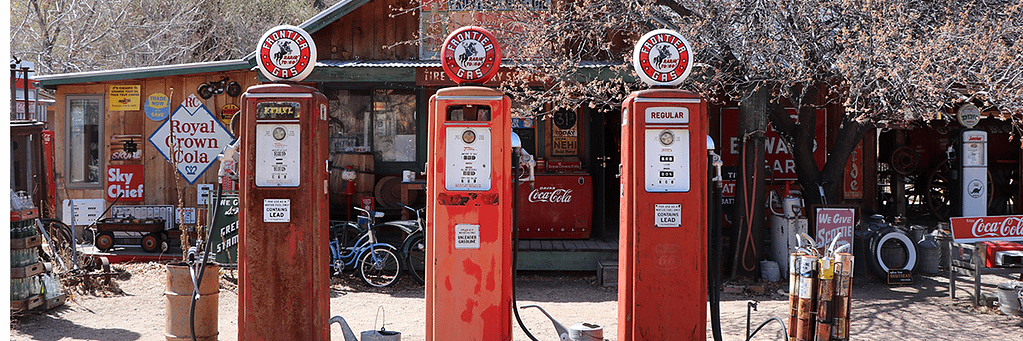
If you know what’s what in Taos you have a copy of the gallery guide.
But what about museums? Taos is a famously historic center of a swirling vortex of mingling narratives, of curious and diverse cultures, stories, and personalities. There are monuments here to the rich tapestry of passing time, the threads that weave this magnificent masterpiece. They’re worth a visit. We’ll explore them below.
Taos Art Museum at Fechin house
In 1923, the artistic Fechin family, led by the illustrious Russian-American painter Nicolai Fechin (pronounced “fay-shin”), embarked on a journey from Russia to the vibrant chaos of New York City. But their real adventure began in 1926 when they answered the siren call of Taos, New Mexico, at the behest of the ever-charming Mabel Dodge Luhan. Fechin purchased a property here in 1927, and after 5 years of inspired labor, the result was a 3,545 square-foot masterpiece of asymmetrical adobe Pueblo and Mission Revival architecture that seamlessly embraced Nicolai’s art and carvings. Sculpting with wood, he wove magic, shaping columns, doors, and furniture. Copper fixtures? He forged those too!
Sadly, marital woes led Nicolai away from Taos, but his wife Alexandra’s devotion preserved the house for 30 years. In 1977, Eya, their daughter, returned, becoming the Fechin House’s savior and curator. Today, the Fechin House stands as a cherished historical gem, a testament to the enduring power of art and family.
Blumenshein house
Nestled on historic Ledoux Street in charming Taos, the E.L. Blumenschein Home and Museum offers a delightful peek into the past. Preserved much as it was when the artist and his family roamed its halls, this home is a treasure trove of Blumenschein family art, a gallery showcasing renowned Taos artists’ works, and a cozy display of European and Spanish Colonial-style antiques. Amid these treasures, you’ll find a vivid snapshot of the artistic lifestyle in Taos during the early 20th century.
The tale of how it all began is a serendipitous one: in 1898, artists Ernest L. Blumenschein and Bert G. Phillips had their fateful surrey mishap on their way to Mexico, discovering the enchanting Taos Valley instead. This happy accident led to the birth of a vibrant American art colony. Bert Phillips remained in Taos, while Ernest returned frequently, often with his wife, Mary Shepherd Greene Blumenschein, a celebrated artist herself. In 1919, they purchased part of the Taos Society of Artists member W. Herbert “Buck” Dunton’s home and began expanding and remodeling it. Parts of the house date back to 1797, a testament to Taos’s rich history. The Blumenscheins’ artistic journey took them from Paris to New York, but in 1919, Ernest finally persuaded Mary to call Taos home. In 1915, the Taos Society of Artists was born, leading to exhibitions across major U.S. cities and putting Taos on the artistic map.
Today, the museum stands as a tribute to the Blumenschein family and the Taos art colony’s legacy, with rooms lovingly preserved to reflect their original charm. Donated paintings from fellow artists and community members add to the rich tapestry of Taos’s artistic history. The home was gifted to Taos in 1962 and recognized as a National Historic Landmark in 1966, forever preserving the enchanting tales of Taos’s art-filled past.

Kit Carson House
The Taos Museum at Kit Carson House stands as a sacred portal into the heart of the 19th century American West, where history whispers in every adobe brick. This National Historic Landmark, built in 1825, cradled the life of Christopher “Kit” Carson, a man of many roles in the untamed wilderness: trapper, explorer, scout, and more. It was his cherished home for 25 years, a symbol of enduring love for his bride, Maria Josefa Jaramillo. But this is not merely the story of one man; it is the tale of a land where countless histories intertwine.
Here, The Taos Museum honors the ancestral roots of New Mexico, a place of diverse cultures and millennia-old encounters. The Taos Museum, an extension of the Kit Carson House, becomes a vessel to recount these stories, to study Kit Carson’s legacy, and to weave together the intricate tapestry of Taos and the Southwest. They embrace authenticity, inclusiveness, partnership, stewardship, and impact as their guiding principles, ensuring that the past speaks to the present, resonating with the spirits of those who walked this land before.
Millicent Rogers Museum
The Millicent Rogers Museum is a vivid tapestry of the Southwest’s arts and cultures, founded as a loving tribute to the dynamic personality Millicent Rogers. From her glamorous social circles in New York City to her later years in Taos, Millicent’s life was a whirlwind of fashion and fascination. Her son, Paul Peralta-Ramos, established the museum in her honor, amassing a remarkable collection of over 7,000 objects. It’s a place where you can journey through time and explore the rich history of Native American, Hispanic, and Anglo arts from the region, with pottery, Santos, textiles, and much more. The heart of the museum is a dazzling turquoise and silver jewelry collection curated by Millicent herself. Every visit is a chance to embrace the diverse heritage of the Southwest in intimate exhibit spaces housed within a historic hacienda, a true treasure trove waiting to be discovered.
Hacienda Martinez
Hacienda Martinez stands as one of the few remaining northern New Mexico-style “Great Houses” from the late Spanish Colonial era. Constructed in 1804 by Severino Martinez, this fortress-like haven with its formidable adobe walls was once a bustling trade hub on the northern frontier of the Spanish Empire, marking the end of the Camino Real that stretched all the way to Mexico City. Severino and his wife Maria del Carmel Santistevan Martinez nurtured their family of six within these walls, including the renowned Padre Antonio Martinez, who fought to preserve the Hispanic essence of the Catholic Church in the region. This dynamic figure also introduced co-educational schooling to New Mexico and brought the territory its first printing press.
Beyond its historical significance, the Hacienda’s twenty-one rooms encircling two enchanting courtyards offer a captivating glimpse into the rugged frontier life of the early 1800s. Today, it continues to breathe life into the traditions of northern New Mexico, inviting visitors to step into the past. This cherished treasure is proudly listed on the National Register of Historic Places, a testament to its enduring value and allure.

Classical Gas Museum
In the small town of Embudo, NM, nestled in the Rio Grande canyon between Española and Taos, lies the whimsical Classical Gas Museum, born from Johnnie Meier’s fascination with road culture artifacts. Since 1987, he’s been collecting vintage gas pumps, neon signs, license plates, and more. After a decade of amassing these treasures, he decided to give them a permanent home. Retiring in 2002, Johnnie poured his heart into the museum and its restoration projects, including a ’50s diner. Hollywood has taken notice, using his props in films like “No Country for Old Men” and “Wild Hogs.” So, if you’re on a road trip, swing by for a chat with Johnnie and a glimpse into road culture history – admission is free, but a donation to the Dixon Animal Protection Society is warmly appreciated.
DH Lawrence Ranch
D. H. Lawrence, renowned author of literary classics, including “Women in Love” and “Lady Chatterley’s Lover,” had a transformative experience in New Mexico. In 1922, Lawrence and his wife Frieda were invited by Mabel Dodge Luhan to visit Taos. Although they only spent eleven months in the state across three visits, New Mexico left an indelible mark on Lawrence. In 1924, they settled on the Kiowa Ranch, gifted to them by Luhan. This 160-acre property, perched at 8,600 feet above sea level, became Lawrence’s muse, inspiring works like “St. Mawr,” “David,” and “The Plumed Serpent.” After Lawrence’s death, Frieda returned to the ranch, and in 1934, she had his ashes placed in a memorial chapel on the property. In 1955, she entrusted the Kiowa Ranch, now the D. H. Lawrence Ranch, to the University of New Mexico for educational and cultural purposes, ensuring that Lawrence’s legacy lives on.
Couse-Sharp Historic Site
The historic site is a delicate tapestry woven with the stories of remarkable artists. E.I. Couse’s home and studio, graced by the garden crafted with love by his wife, Virginia, stand as the heart of the site. Nearby, his son Kibbey’s workshops echo with the residue of a rich creative practice. Sharing this artistic haven, Joseph Henry Sharp’s studios whisper tales of bygone inspiration. Yet, beneath this patchwork of creative workspace lies a rich history, dating back to the defensive days of Old Spanish Taos. From humble beginnings as Juan de Luna’s family chapel in 1835, the site evolved, growing with each owner’s touch.
The Couses brought their vision in 1909, adding a studio and a garden that would flourish with time. Kibbey, with dreams of a mobile machine shop, shaped the site further, and after his parents’ passing, the serenity of this artistic haven remained untouched. Nearby, J.H. Sharp’s journey added layers to this enchanting tale, as his studios and Luna chapel became integral to the site. Today, it’s a place where history and art intertwine, creating a delicate and charming portrait of the enduring spirit of the arts.
In a town steeped in history, Taos’ museums are windows into the past, offering a glimpse into the diverse and captivating tales of this unique region.

